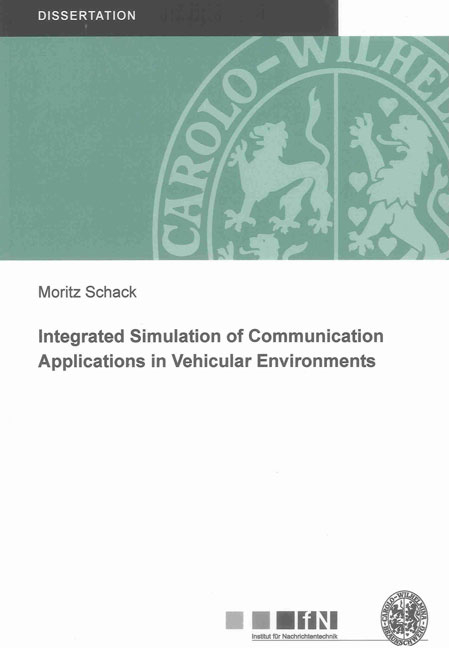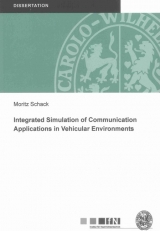Integrated Simulation of Communication Applications in Vehicular Environments
Seiten
2013
|
1., Aufl.
Shaker (Verlag)
978-3-8440-1622-2 (ISBN)
Shaker (Verlag)
978-3-8440-1622-2 (ISBN)
- Keine Verlagsinformationen verfügbar
- Artikel merken
Cell phones have already become more than “simple” communication devices and are used even when driving. For this purpose, a connection of in-vehicle devices with a mobile communication network has to be established. Due to the metallic body of the vehicle accompanied by strong radio field attenuations, the in-vehicle coverage is partly not provided and the successful use of services cannot be guaranteed. This problem could be solved by splitting the communication link into two parts. On the one hand, the passengers’ mobile devices are integrated into a wireless in-vehicle network provided by the vehicle itself. Thus, the passengers are able to access all kinds of content managed by the central multimedia platform of the vehicle. For the purpose of setting-up in-vehicle communications, Ultra Wide Band (UWB) as well as 60 GHz short-range systems are potential solutions due to high data rates and very low-cost devices. The adaption of these systems to the properties of the vehicle interior enables high-quality links. On the other hand, the vehicle is connected with surrounding communication networks in order to access the desired infotainment services and to receive traffic information to enhance the road safety as well as traffic efficiency. For example by forwarding information about traffic hazards in areas of limited visibility, other vehicles in the vicinity can be warned beforehand. Therefore, highly robust data transmission with low latencies as well as high locality is required. This can be achieved with the introduction of the so-called Vehicle-to-X (V2X) communication enabling vehicles to communicate directly with their surrounding infrastructure (Vehicle-to-Infrastructure (V2I) communication) as well as with each other (Vehicle-to-Vehicle (V2V) communication). In order to ensure a reliable deployment of communication applications in the vehicular environment, a previous validation of the system has to be performed.
This thesis deals with the simulation of communication applications in vehicular environments with the main focus on the radio channel, on the influence of the antenna configuration as well as on the Packet Error Rate (PER) performance of the Physical Layer (PHY). For the validation of V2X communication systems and applications, several interconnected and specialized simulation tools are integrated into a comprehensive simulation environment. It consists of modules to simulate the PHY, the vehicular mobility as well as the radio channel. A self-developed deterministic 3D ray-optical model is used in order to achieve a realistic description of the channel for specific V2X scenarios. Since ray-optical models are still very time-consuming and the computing time is crucial for the overall performance of the simulator, two optimizing acceleration techniques are developed and evaluated. The selection of an optimum antenna configuration, the urban vehicular radio channel and the PER performance of the PHY are investigated for specific situations with the aid of the integrated simulator. Moreover, a stochastic propagation model for urban crossroads scenarios including the influence of an application-specific antenna module is developed on the basis of the simulation environment. With this approach, the feasibility of a V2V application is analyzed in worst case scenarios.
Since the dimensions of the objects within the vehicle are smaller than the wavelength of the considered in-vehicle systems, an application of the deterministic ray-optical model is not feasible. Thus, extensive UWB channel measurement campaigns in a variety of scenarios and different vehicles are carried out. The influence of the vehicle type, the antenna position and the occupation by passengers is in the focus of this thesis. The in-vehicle UWB channel is analyzed and empirical models are derived consequently. Furthermore, the performance and the feasibility of a UWB system in terms of the Bit Error Rate are investigated using a PHY simulator. Finally, a comparison of UWB and 60 GHz inside vehicles with respect to the channel properties is examined.
This thesis deals with the simulation of communication applications in vehicular environments with the main focus on the radio channel, on the influence of the antenna configuration as well as on the Packet Error Rate (PER) performance of the Physical Layer (PHY). For the validation of V2X communication systems and applications, several interconnected and specialized simulation tools are integrated into a comprehensive simulation environment. It consists of modules to simulate the PHY, the vehicular mobility as well as the radio channel. A self-developed deterministic 3D ray-optical model is used in order to achieve a realistic description of the channel for specific V2X scenarios. Since ray-optical models are still very time-consuming and the computing time is crucial for the overall performance of the simulator, two optimizing acceleration techniques are developed and evaluated. The selection of an optimum antenna configuration, the urban vehicular radio channel and the PER performance of the PHY are investigated for specific situations with the aid of the integrated simulator. Moreover, a stochastic propagation model for urban crossroads scenarios including the influence of an application-specific antenna module is developed on the basis of the simulation environment. With this approach, the feasibility of a V2V application is analyzed in worst case scenarios.
Since the dimensions of the objects within the vehicle are smaller than the wavelength of the considered in-vehicle systems, an application of the deterministic ray-optical model is not feasible. Thus, extensive UWB channel measurement campaigns in a variety of scenarios and different vehicles are carried out. The influence of the vehicle type, the antenna position and the occupation by passengers is in the focus of this thesis. The in-vehicle UWB channel is analyzed and empirical models are derived consequently. Furthermore, the performance and the feasibility of a UWB system in terms of the Bit Error Rate are investigated using a PHY simulator. Finally, a comparison of UWB and 60 GHz inside vehicles with respect to the channel properties is examined.
| Erscheint lt. Verlag | 20.1.2013 |
|---|---|
| Reihe/Serie | Mitteilungen aus dem Institut für Nachrichtentechnik der Technischen Universität Braunschweig ; 27 |
| Sprache | englisch |
| Maße | 148 x 210 mm |
| Gewicht | 276 g |
| Einbandart | Paperback |
| Themenwelt | Technik ► Elektrotechnik / Energietechnik |
| Schlagworte | Car-to-Car-Kommunikation • In-vehicle communication • Kraftfahrzeug • Simulation • V2X Communication |
| ISBN-10 | 3-8440-1622-8 / 3844016228 |
| ISBN-13 | 978-3-8440-1622-2 / 9783844016222 |
| Zustand | Neuware |
| Haben Sie eine Frage zum Produkt? |
Mehr entdecken
aus dem Bereich
aus dem Bereich
DIN-Normen und Technische Regeln für die Elektroinstallation
Buch | Softcover (2023)
Beuth (Verlag)
86,00 €
Kolbenmaschinen - Strömungsmaschinen - Kraftwerke
Buch | Hardcover (2023)
Hanser (Verlag)
49,99 €




